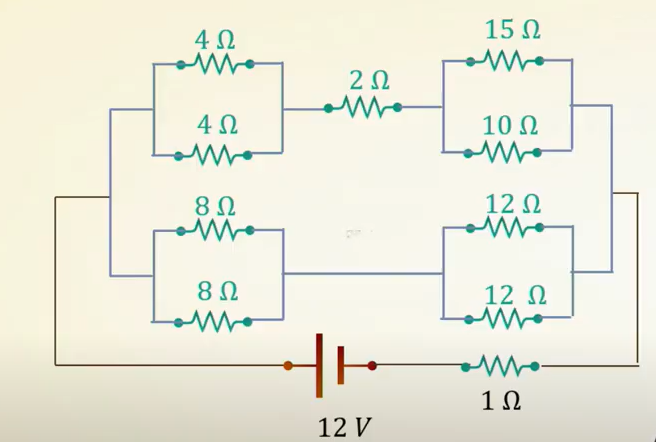In Ohm's law experiment, potential drop across a resistance was measured as v=5.0 volt and current was measured as i=2.00amp. Find the maximum permissible error in resistance.
1.5%
2.5%
1%
5%
The correct Answer is:B
R=vi=v×i⇒(dRR)max=Δvv+Δii
v=5.0volt toΔv=0.1volt
i=2.00amptoΔi=0.01amp
%(dRR)max=(0.15.0+0.012.00)×100%=2.5%
value of R from the observation
R=vi=5.02.00=2.5Ω
So we can write R=(2.5±2.5%)Ω
Topper's Solved these Questions
- EXPERIMENTAL PHYSICSBOOK - NARAYNACHAPTER - EXPERIMENTAL PHYSICSEXERCISE - Multiple answer
6 Videos
- EXPERIMENTAL PHYSICSBOOK - NARAYNACHAPTER - EXPERIMENTAL PHYSICSEXERCISE - Passage
6 Videos
- EXPERIMENTAL PHYSICSBOOK - NARAYNACHAPTER - EXPERIMENTAL PHYSICSEXERCISE - Comprehension type
6 Videos
- ELECTROSTATICS AND GAUSS LAWBOOK - NARAYNACHAPTER - ELECTROSTATICS AND GAUSS LAWEXERCISE - Intergers type question
11 Videos
- MAGNETISMBOOK - NARAYNACHAPTER - MAGNETISMEXERCISE - LEVEL-II (H.W)
24 Videos
Similar Questions
In Ohm's law experiment , the potential drop acros a resistance was as V=5.0V and the current was measured as I=2.00A. Find the maximum permissible error in resistance.
View SolutionIn ohm's law experiment potential drop across a resistance was measured as v=5.0 volt and current was measured as I=2.0amp If least count of the volmeter and ammeter are 0.1V and 0.01A respectively then find the maximum permissible error in resistance .
View Solution
Knowledge Check
Assertion(A): In Ohm's law experiment potential drop across a resistance wire was measured as 5.0V and current was measured as 2.00A. The maximum permissible error in resistance is ±25%
Reason(R ): In experiment of assertion the least count of ammeter is 0.01A.ABoth assertion and reason are true and the reason is the correct explanation of the assertion.BBoth assertion and reason are true but the reason is not the correct explanation of the assertion.CAssertion is true but reason is false.DAssertion is false but reason is true.A voltmeter has a least count of 0.1 V and an ammeter has a least count of 0.1 A. The potential drop V across a resistance is measured as 10.0 V and current through it is measured as 1.0 A .Select the correct alternative
AThe value of R is (1.0±0.1)×101ΩBThe relative error in measurement of current is 110CThe accuracy in measurement of potential drop is 1100DThe value of R is (10+0.2)ΩThe voltage measured across resistance is V=(50±0.1)V and current isI=(10±0.2). Find error in resistance
A±1.12ohmB±0.11ohmC±0.21ohmD±2.12ohm
Find potential across 15ohms resistance.

View SolutionIn the previous question, find the maximum permissible error in resistivity and resistance.
View SolutionIn case of a bipolar transistor the
potential drop across the collector
resistance of 500 Ω is 4.5 V and β=200 . Find the base current ( in μA) in the transistor.
View SolutionIn the experiment of Ohm's law, a potential difference of 5.0 V is applied across the end of a conductor of length 10.0 cm and diameter of 5.00 mm. The measured current in the conductor is 2.00 A. The maximum permissible percentage error in the resistivity of the conductor is :
View SolutionThe resistance of a metal is given by R=V/I , where V is potential difference and I is current . In a circuit , the potential difference across resistance is V=(8±0.5)V and current in resistance , I=(4±0.2)A. What is the value of resistance with its percentage error?
View Solution
